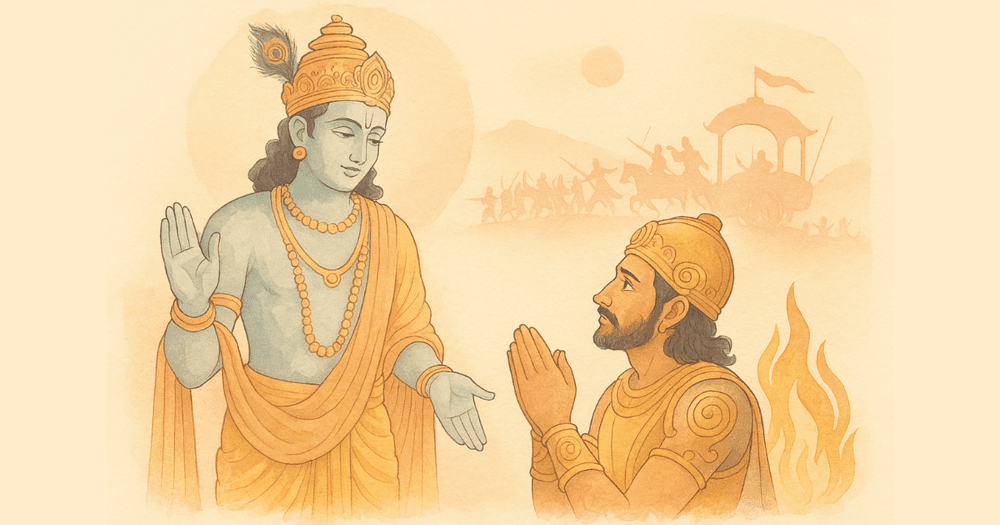The Gita’s Profound Message: Pain Has a Purpose, Do Not Waste It
By Pt. Suvrat Sharma
Pain, Transformation and Liberation - Insights from Ramayana, Vedas, Mahabharata and the Puranas

Table of Contents
Pain is the greatest truth of life, often making a person feel helpless before it. Yet, the Gita affirms time and again-every pain, crisis and tear holds a higher purpose. All our sacred texts-Vedas, Ramayana, Mahabharata and Puranas-richly confirm this.
Pain as the First Guru: The Dialogue of Arjuna and Krishna
On the Mahabharata battlefield, Arjuna is shattered by the weight of attachment, duty and fear-when at that very moment, a new doorway within himself opens. Krishna does not console; he questions. In Gita 2.11, “You grieve for those who should not be grieved for, yet you speak wisely.”
It is pain that propels Arjuna toward introspection, self-realization and wisdom.
Lesson: Whoever embraces pain as a teacher, finds their life redefined.
The Fire that Burns Away the False: Ramayana and Upanishads
The fire ordeal in the Ramayana is not just about Sita-it tests all humanity’s fears, blame and notions of social purity. Sita’s exile and trials-all become nourishment for her inner power, truth and dignity.
In the Vedas, Agni is the purifier. He burns all impurity and bondage. The Isha Upanishad also prays-“Agne nay supatha”-O fire deity, lead us on the noble path, burn away all that chains us.
Table: The Fire of Pain and the Awakening it Brings
| Scripture/Character | What Pain They Endured | What They Realized or Gained |
|---|---|---|
| Arjuna | Attachment, conflict, war | Insight, philosophy, dharma |
| Sita | Slander, exile ordeal | Truth’s strength, freedom |
| Nachiketa - Upanishads | Death, uncertainty | Brahma-knowledge, immortality |
| Bhishma | Loss, loneliness, vow | Forgiveness, peace, dialogue |
From “Why Me?” to “What For Me?” - Lessons from the Puranas
When gripped by pain, the question is often “Why?” The Gita and our sages ask-“What is its purpose?”
Shiva, during the ocean’s churning, chose to drink poison for the good of the world. Suffering was accepted to save all existence.
Sati bravely accepted humiliation and scorn at Daksha’s Yajna, sacrificing herself by fire but was immortalized by Shiva in the universe.
Pain: Catalyst or Chain? Mahabharata, Bhagavatam and Life Itself
Draupadi’s pain was not just humiliation; she transformed it into devotion and a force for dharma. Her faith and questioning shaped the fate of generations.
Karna’s pain over social status never left him. His struggle, generosity and pride until his very death remain one of history’s greatest inspirations.
| Story | Form of Pain | Awakening or Purpose |
|---|---|---|
| Draupadi | Insult, separation | Faith, resilience, living example |
| Karna | Social pain | Charity, unwavering pride |
Where is the Power in Pain? Upanishads, Sati, Drona, Arjuna
Upanishads repeatedly declare, “Tapasa ghoram achanti”-without intense discipline and the acceptance of pain, there is no immortality.
Dronacharya let Arjuna stumble repeatedly, so he would develop determination and true mastery.
Shiva’s profound silence answered Parvati’s penance and pain.
Krishna’s Message - Turn Your Pain into Strength
Krishna teaches-“Yogasthah kuru karmani.” Do not run from pain, confusion or failure but transform every experience through yoga and right action.
“No one who does good ever comes to a bad end.” (Gita 6.40)
FAQs (Based on Deeper Stories and Insights)
1. Is there pain that yields no lesson?
Any hardship can trigger awakening. If one is willing to accept, pain becomes teacher.
2. Which pain is the hardest in epics?
Loss of loved ones (as with Bhishma, Arjuna, Draupadi), social disgrace (Karna, Sati), self-doubt (Nachiketa)-all appear in many shades.
3. Can any ordinary person find meaning in pain like these stories?
Certainly. Parents, students, seekers, workers-with open hearts, pain can change one’s very direction.
4. Is pain always a strength or a chain?
Run from it and it stays a shackle. Accept and learn from it and pain becomes fuel.
5. Which Gita verse beautifully illustrates pain’s power?
“Yogasthah kuru karmani, sangam tyaktva dhananjaya”-do your work through yoga, detached from pain, joy or result.
Every Age, Every Hero and Every Story Offers the Same Truth
Pain is not fate, not simply a warning, not just an obstacle; it is the world’s deepest fountain of learning, the force that shapes real greatness. Do not let it be wasted-this is the unending message of Gita and the epics.
Get your accurate Kundali
Generate KundaliDid you like it?
Author

Pt. Suvrat Sharma (50)
Experience: 27
Consults About: Marriage, Career, Property
Clients In: Chhattisgarh, MP, Delhi, Odisha
Share this article with friends and family